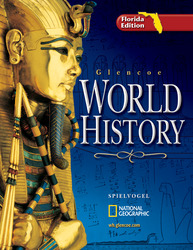Glencoe World History, Florida EditionChapter 15:
The Muslim Empires, 1450–1800Chapter OverviewsBeginning in the fourteenth century, the Ottomans built a large empire in Western Asia, North Africa, and parts of Europe. In the sixteenth century, the Safavids came to power in Persia and Central Asia, while the Moguls unified India. Section 1 The Ottoman Empire
With the decline of the Seljuks in the early fourteenth century, the Otttoman Turks embarked on a rapid expansion across modern-day Turkey and the Balkans. Over a span of 300 years, the Ottomans conquered large areas of Western Asia, North Africa, and Europe. Ottoman officials, assisted by trained bureaucrats, handled the administration of conquered lands. Senior officials received land grants and were responsible for collecting taxes and supplying armies from those lands. Starting in the sixteenth century, sultans claimed the title of caliph, while religious advisers, the ulema, oversaw the application of Islamic law. The Ottomans were generally tolerant of non-Muslims, some of whom converted to Islam. The Ottomans' greatest artistic contribution was the building of magnificent mosques. After the death of Süleyman the Magnificent, corruption and palace intrigue spread, and wars depleted the Ottoman treasury. Western cultural influences also increased. Section 2 The Rule of the Safavids
In the early sixteenth century, a new dynasty, the Safavids, came to power in Persia and Central Asia. The Safavids used their Shiite Muslim faith to unify Turkish peoples and Persians. Like the Ottoman sultan, the Safavid shah claimed to be the spiritual leader of Islam. The two empires clashed repeatedly over territory. The Safavids created a professional bureaucracy of Turkish and Persian officials and reined in the aristocracy. They also interacted with the people in their empire. The empire reached its high point under Shah Abbas. Trade and manufacturing thrived, although Safavid Persia suffered from limited contact with European markets. The arts and sciences also thrived. Afghan invasions in the early eighteenth century marked the end of Safavid rule, and Persia sank into a long period of anarchy. Section 3 The Grandeur of the Moguls
The Moguls came from north of the Indus River valley and conquered India when it was still divided into a number of Hindu and Muslim kingdoms. The sixteenth-century Mogul leader Akbar largely completed the task of unifying India and oversaw a period of stability and prosperity. Born a Muslim, Akbar was a humane ruler who established a policy of religious tolerance. Under his successors, the empire expanded, but its treasury was depleted. The ending of religious tolerance led to widespread Hindu unrest. In 1739, Persians invaded and sacked Delhi. British influence throughout India hastened the decline of the Moguls. The growing military and economic power of the East India Company sapped Mogul power and prosperity while enriching British officials and merchants. Mogul rule led to the blending of Muslim and Hindu cultural practices. Mogul patronage of the arts brought together Persian and Indian influences, especially in painting and architecture.  | 

















